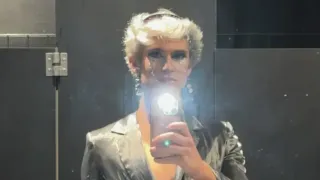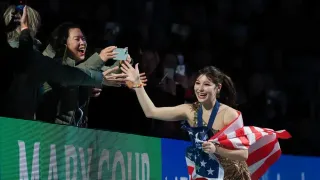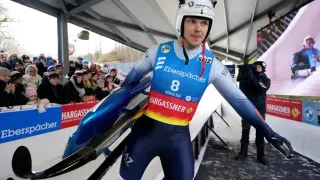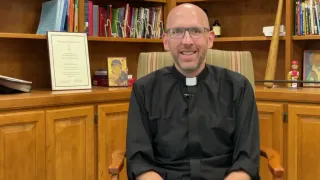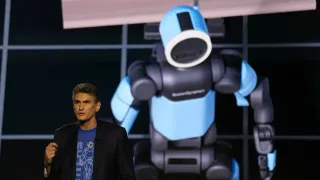July 21, 2014
Astro Boy & The God of Comics
Kilian Melloy READ TIME: 4 MIN.
Company One presents a multi-faceted, visually dynamic, narratively scattershot m�lange of biography, comedy, drama, manga, and more. Natsu Onoda Power directs her own script at the Boston Center for the Arts through Aug. 16.
Power -- who is based in Washington, D.C., and teaches at Georgetown -- has startling, ambitious vignettes to offer in "Astro Boy & The God of Comics," though its hard to categorize just what kind of play this is meant to be overall. It's more than a standard theatrical presentation: A complex projection design, psychological profundity, pop-culture frivolity, a smattering of live music, and a lot of live drawing figure into the mix. As performance art, this is top-drawer. In terms of narrative coherence and plot, though... let's just say if one were make a simile between the literary nature of "plot" and the clean, fluid clarity of an artist's inked line, "Astro Boy" relies on pointillism to create the image the viewer mentally assembles, takes home, and ruminates over.
The show consists of a dozen short segments, arranged in reverse chronological order. We begin with the final adventure of superhero robot Astro Boy's (Ginalella Flores), based on the last episode of the original animated television series. From there, the show re-traces canonical moments from Astro Boy's career: His re-activation by Dr. Elefun (Phil Berman), his suffering at the hands of a circus master named Cacciatore (ensemble member Robert St. Laurence), his rejection by creator Dr. Tenma (Clark Young) because he is unable to replicate a biological boy's maturation process, and eventually the reason he was created in the first place -- the tragic death of Dr. Tenma's son. But these segments aren't presented as short scenes in the usual sense of the word; they take a variety of forms, from news broadcast to infomercial.
The vignettes also cover the life of Osamu Tezuka (Clark Young), Astro Boy's creator, both in animation and in the long running comic book series. Tezuka is the "god of comics," partly for the inventiveness of his artistry and his world-building, and partly because of his unbelievably prolific output. A workaholic whose early life was marked, and marred, by an increasingly martial and inflexible Japanese society, Tezuka made social issues a crux of his storytelling; in the "Astro Boy" comic books and TV series, for example, one continual source of dramatic tension was the struggle by sentient robots for civil rights.
Tezuka was deeply influenced by movies, of which he was an ardent fan, as well as by his experiences before and after World War II, which included not only calcifying social attitudes that viewed dissent and art with suspicion, but a sometimes-brutal American occupation after the Japanese surrender in the wake of atomic weapons being used on Horoshima and Nagasaki. (It's no doubt Freudian that the original Japanese title of "Astro Boy" is "Mighty Atom.")
Tezuka was also a graduate of medical school, though his calling as a manga artist now seems foreordained: As a college sophomore, he wrote and drew a seminal graphic novel called "New Treasure Island," the opening pages of which the play's ensemble, working in perfectly choreographed sync (as they do for so much of the show), re-enact. Near the end of the 80-minute production, home movies of Tezuka's early life join the production's plethora of other projected images on a large screen at the back of the performance space -- a screen made to look like a single frame of movie film, but which also serves as a canvas for the ensemble's interactive bouts of art. (In one memorable turn, they create a tableau that comes across as a sort of mini-"Guernica," a powerful visual indictment of the waste and horror of war.)
Whether you love, love, love "Astroboy" or appreciate its technical accomplishments while finding its story merely okay will be a matter of what you are looking for, and also a matter of taste. (Manga is not for everyone.) The ensemble (which also includes Jessica Chance, Jeff Song, and Kaitee Treway) and technical crew (among them projection designer Jared Mezzocchi, lighting designer Justin Paice, costume designer Tyler Kinney, and sound designer Kelsey Jarboe, whose work here is superb even among a wealth of superb work) bring buckets of multi-media talent to the show, not to mention a huge dose of high-wattage charm.
The one real word of warning you need to hear is this: Although the theater has been set in a three-quarter thrust configuration, the show has been staged for a proscenium. The best seats in the house are in the center section of the house, from which you'll have a clear view not only of the screen at the back but also a screen placed, from time to time, in front of the actors. Projection is a key element of this production, but some important projections are not visible from the left and right side of the thrust seating.
"Astroboy and the God of Comics" continues through August 16 at the Boston Center for the Arts. For tickets and more information, please visit www.companyone.org
